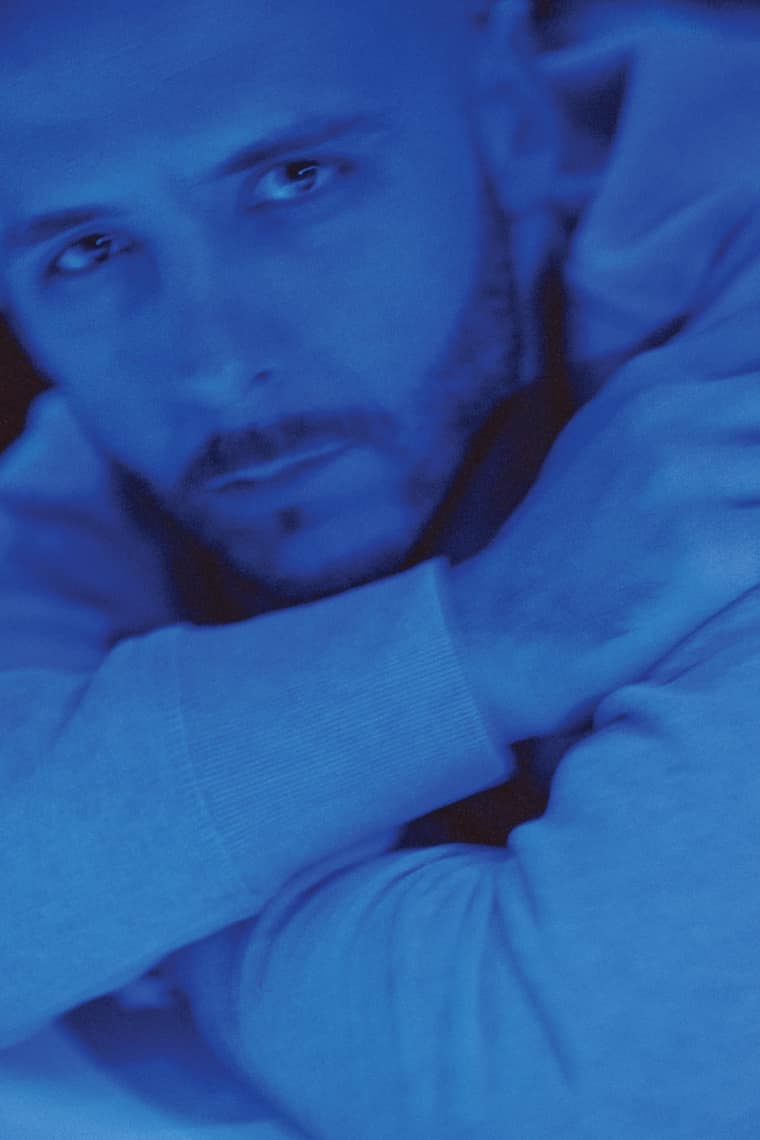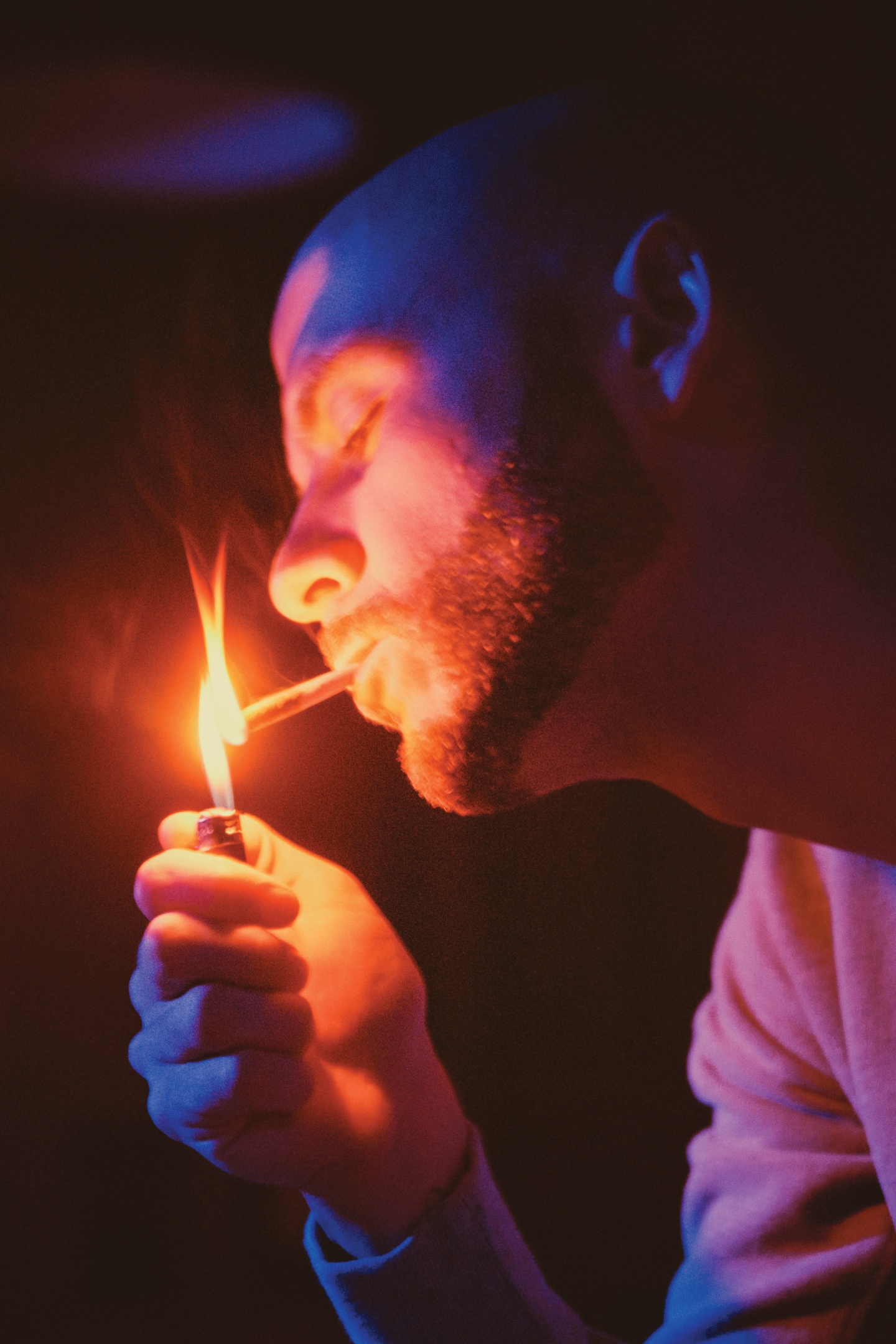OVO’s Family Business
With his friends, Drake made OVO an institution. Now the men behind the boy are figuring out what to build next with all that power, and how they’ll do it.
 Noah "40" Shebib
Noah "40" Shebib
 Oliver El-Khatib
Oliver El-Khatib
Across the street from S.O.T.A. Studios, a brand new live/work complex in an industrial cul-de-sac at the edge of Toronto’s West End, a blonde in a colorful sports bra and a pair of running shorts stands atop a speed boat parked in a gravel lot, cleaning it with a hose and a bucket. It’s a humid August day, the sun is way up in the sky, and the neighborhood is quiet, save the occasional car driving by. The woman likely has no idea what goes on in the squat gray building 100 feet away, where Drake records and where October’s Very Own—the label and clothing brand he jointly owns with manager Oliver El-Khatib and engineer and producer Noah “40” Shebib—has recently planted new roots. There are two cars parked outside; near the entrance, a pair of hockey nets is set up.
Drake has been famous since the early days of the Obama presidency. Meanwhile, the team that’s buoyed his career has operated partly under shadow. Drake’s OVO associates have avoided press and chosen to let Drake speak as their representative; the likable picture he’s drawn in return is an aspirational folktale, of a kid from Toronto who became a star with the help of his best friends. But as Drake enters a new stratosphere of pop stardom, OVO is reckoning with what it means to scale a small business. The construction of the multi-million dollar studio and office space has marked an important step for the company—a centralization of its sprawling efforts, and a more formal approach to its undeniable growth.
S.O.T.A.—the acronym stands for “state of the art”—was built over the course of a year and a half by 40, the producer largely responsible for masterminding Drake’s sound and the superintendent of the OVO Sound label. This is where he and Drake have been working on Drake’s upcoming album, Views From the 6, but it’s also 40’s home; only a door separates his condo from the studio and office. In the studio’s sparse and modern lounge, abstract black-and-white geometric shapes jut out from the wall, and a blue light beams from the ceiling, brightening up the space-gray decor. Everything is sleek and cold, except for a watchful wooden owl sitting alone on a white cabinet. The figure looks like the crew’s official logo, a minimalist outline derived from the birdlike look of the letters that form OVO.
When I meet 40 there, he’s coasting on two-and-a-half hours of sleep. (Insomniac dedication to work earned Shebib his nickname—40 is shorthand for “40 days and 40 nights,” the mythical length of time he’d stay up to work on a project.) He’s dressed in a white-and-blue T-shirt from a recent OVO collection, and the hem of his light blue jeans spills over a pair of white-and-gold OVO Jordan 10s, produced with Jordan Brand as part of its first endorsement of someone who isn’t an athlete.
Later, perched on a chair behind his boards, 40 points to an elevated part of the studio where a cushioned bench lines the wall. “I sit here,” he says. “Drake sits there. We work.” The two have been at each other’s sides for seven years—“for some reason, the way Noah hears things is the way I hear it,” Drake told The FADER in 2011. “We have a creative relationship,” 40 says. “We go into the studio and we make music together, and that’s the most important thing to me. I protect that with my life.”
40’s instinctual understanding of Drake’s nuances, and the technical know-how he learned as an intern of legendary engineer Noel “Gadget” Campbell, have been instrumental to Drake’s success. With S.O.T.A., 40 now aspires to also become “an ultimate resource” for PARTYNEXTDOOR, Roy Wood$, Majid Jordan, and the other artists on OVO Sound’s growing roster who’ll use the studio as a clubhouse. “I’m able to help them with their process and how they’re recording, or with toys and instruments and machines that they didn’t maybe know about,” he says. “I can expose them to knowledge. I pride myself on my skill sets. I care about this stuff. I built this massive place, right?”
The skilled community that will work at S.O.T.A. is a living rebuttal to the old idea that being from Toronto ruined your chances of global music industry success. “The conversation when I was a kid was, ‘Will anyone ever do it?’ The conversation now is, ‘Who’s next?’” 40 says. “Someone else is gonna come through a door [that Drake opened], but I don’t know if someone else will ever make a difference like that. We did the heavy lifting. No one else has to come do that heavy lifting again. It’s been done.”

“Someone else is gonna come through a door [that Drake opened], but I don’t know if someone else will ever make a difference like that. We did the heavy lifting. No one else has to come do that heavy lifting again. It’s been done.” —Noah “40” Shebib
Within OVO, Drake is the leader—the boy, as they all call him, to rally around. And sitting on his proverbial shoulders, yelling in each ear, are 40 and Oliver El-Khatib, Drake’s manager, longtime creative confidante, and friend. “Truth be told, Drake’s career has always been the three of us knocking our heads off a table, trying to figure everything out,” 40 says. “That’s the power of OVO.”
Oliver and 40 were close before either met Drake. They became friends in grade 9 homeroom and were members of a DJ collective called the Lebanon Dons. From 2008 to 2009, they were roommates, living in a condo along Toronto’s lakeside. Oliver worked for a retailer that owned three menswear boutiques, and 40 eked out a living at an arts nonprofit while engineering on the side. 40 heard Drake’s Boi-1da-produced “Do What U Do” on the radio and wondered who the boy with the new flow was; around the same time, Drake was looking for 40, an engineer with a budding reputation, to help him record a follow-up project. “I was hunting for him, he was looking for me,” 40 says. The two only met, though, after Oliver passed 40 Drake’s number and nudged them together when they found themselves in the same room: “It was Oliver who gave me the kick in the ass I needed,” says 40.
Today, Oliver helps manage Drake’s career and oversees the growth of OVO’s clothing line. Leadership comes from others too—Drake’s longtime DJ-turned-co-manager Future the Prince, and Majid Jordan’s manager Drex Jancar, for instance—but 40 and Oliver, 40 says, create “balance” in OVO, helping the team cover necessary ground by piloting divergent initiatives. 40 makes sure the songs sound like they should, and Oliver looks after everything else—or, as 40 puts it: “the brand, where we’re going, the feeling, the vibe.”
Sitting at a marble dining table in his Toronto apartment, not far from where he grew up, Oliver defines himself as a “worker, not an artist.” He connects dots, curates the moodboard. Back in 2008, it was Oliver that suggested the Tears for Fears sample and that helped give Drake’s breakthrough 2009 mixtape, So Far Gone, its off-kilter, pastiche texture. “The joy of my life is making music with those two guys,” he explains. “I don’t physically play an instrument or produce records. The charm of what I bring to the table is that sometimes it’s just ideas.”
Early on, Oliver’s impact was most visible on OVO’s blogspot, where he began to stitch together an identity for the company under the alias Olivier the Parisian Gangster. The blog’s first post was published in April of 2008—a photo of Oliver wearing a distressed Canadian tuxedo, a cigarette dangling from his lips, along with this short mission statement: “Thank you, Thank you. This note will be consisting of things that I personally co-sign and or find of interest. Please enjoy and feel free to comment. Peace, O.”
The site gathered fashion photos he liked, plugged the stores he worked at, and shared music he and the crew deemed important. If it was cool, it would get love. Seven years later, Oliver is a widely recognized curator. His ear drives OVO’s biweekly show on Apple Music’s global streaming network, Beats 1, which has premiered new Drake and Majid Jordan songs since its launch in June. The show has also promoted a new crop of Toronto artists—young rapper Safe, and spoken-word artist Mustafa the Poet—as well as little-known British rappers like Nines and Section Boyz. This is a meritocracy, like the blog before it, where anyone can earn a look. “There is no nepotism or favoritism in that radio show or anything we do,” Oliver says.

“It’s not a job that we all go home from. It’s something that we’ve put our own time and money and equity into, and we’re building it with hammers and nails.” —Oliver El-Khatib
These days, Oliver’s main project is OVO’s fashion line. OVO collaborated with brands like Canada Goose and Roots Canada on designs for high-end coats and jackets in 2011, the same year they sold their first in-house product: T-shirts featuring the owl logo. Now, the company is producing a wider line: hats, graphic tees, and sweatshirts, but also towels, tracksuits, tote bags, and, more recently, cut-and-sew button-ups. Product drops follow their own schedule, with limited runs of new designs arriving every month or two. “I’m really proud of where the brand is at today,” says Oliver. “The clothing business is a tough business to go into and have success. It’s something that takes a long time, and it’s an immense amount of work—you’re working 16, 18 months out.”
As they take on the logistics of making clothes, Oliver emphasizes that OVO remains a “mom-and-pop” operation, owned by itself. “If there is any idea that this is some massive corporate entity that’s worth billions of dollars, then that’s a misconception,” he says, laughing. “There’s a few of us putting our blood, sweat, and tears into this 24/7. It’s a lifestyle. It’s not a job that we all go home from. It’s something that we’ve put our own time and money and equity into, and we’re building it with hammers and nails.”
OVO products are sold through a minimalist e-shop and at a meticulous brick-and-mortar store in Little Portugal, a slowly gentrifying strip of quickly gentrifying Toronto. “This seemed like a place that was going to be sustainable for us,” Oliver says of the store’s location. “We’re a destination, so it wasn’t going to matter if we were in a central or upscale area.” A year after its doors opened, it’s not unusual to see kids lined up outside to cop new hats or just catch a glimpse of OVO crew members through the glass storefront. Oliver calls the shop OVO’s “tangible access point” and says he’s “100 percent” involved with its design and staffing. “Who’s working in the store? What music is playing in the store? What’s the vibe in the store? What’s the temperament in the store? That’s a complete extension of our brand. It’s very, very important for people to be able to go there and see what it is,” he says.
The shop is an exercise in clever marketing and offers an additional income stream—hats are priced at $45 CAD and a full tracksuit can run you as much as $300—but it’s also a symbol of OVO’s devotion to Toronto and their desire to change the city’s cultural landscape. Growing up, Oliver says he “never really saw a clear path” for himself in school, and struggled to find mentorship or entry points into Canada’s limited creative industries. Now that he’s made himself successful in a creative role that bridges music and fashion, he sees the store as a way to celebrate kids like his younger self, who have “incredible work ethic, incredible ideas, and an incredible amount of passion.” He envisions the space as a place where creatives can “come together and meet other people like them,” and where eventually those meetings will result in “something new.”
Ten years ago, Oliver might have left Toronto for New York, L.A., or London to find work and build a life. Today, OVO’s example has arguably made it more appealing for young people to stay put, and the store is a symbol of possibility and pride. “We’re from a city where I’m not sure if we’ve fully embraced our identity as creative people yet,” Oliver says. “If there’s anything that we want to put forth, it’s just to have some patriotism for what we’re doing here and to look within for talent and for inspiration.” This vision has earned him fans of his own; in a YouTube video scrutinizing OVO’s Spring 2015 products, a young reviewer says, “Oliver, I look up to him so much. More than I look up to Drake, honestly.”
For years, Drake, 40, and Oliver’s stated goal has been to make the city proud. And now that together they’ve sold millions of records and built an undeniable brand, the city is proud—rallying behind the Raptors (Drake serves as the NBA team’s global ambassador) and calling itself The 6 (a nickname popularized by Drake in the past year, drawn from Toronto’s 416 and 647 area codes). The annual OVO Fest now features an educational seminar (OVO Summit) and a community basketball championship (OVO Bounce), events that tease the kind of programming OVO might support in Toronto down the line. But to expand their offerings, Drake must continue to thrive—if he crumbles, everything could crumble with him. “Drake has to stay touring and keep the machine running so that we can help the city. I want to start setting up more speaking engagements, community programs with music programming,” 40 explains. “If he just stops everything he’s doing, what happens next?”

Asked about his vision for OVO’s future, Oliver is reluctant to pin down the company’s next moves, perhaps aware that as OVO grows bigger, its reputation will be harder than ever to have charge of. The music industry is volatile, audiences are fickle, and no amount of talent can guarantee buzz. For a company like theirs, the key to long-term success is both simpler and more elusive than opening more stores or breaking sales records: as one trend gives way to the next, they always need to stay relevant. “I’m proud of the work that the team has done and I’m a part of that. I’m proud, but there’s no time to celebrate,” he says. “I live my life by letting the work do the talking,” he says. “I do my very best. It’s good to have goals, but sometimes the goals are just for yourself. They don’t need to be shared. All you can do is focus on what’s within your control.”
As they’re beginning to put in work on Views, the crew appears cautiously anxious. Drake has sustained an incredible run, producing hit songs and cultural flashpoints with seeming effortlessness, helping OVO flourish as a result. Now, together, they’re finding out how long a person can do this for. “That’s where the challenges start to lie—‘Well, can you do it again? Can you do it again on demand? Can you do it again on demand after that?’ That’s what separates the greats, is when you’re able to step up time and time again, and deliver,” 40 explains.
OVO will approach Views in much the same way as they’ve approached projects since their earliest days, Oliver says. For Drake, 40, and Oliver, that means holing up in the studio, knocking their heads together, and only stopping when it’s good. “We’re just really getting back to basics and not giving ourselves any sense of deadline,” Oliver says. “Just letting it happen naturally. That’s how we’ve always done it. When it’s done, it’s done. If we love it, we love it.” He steers Drake’s career and the calculated strategy behind it, but true to OVO’s foundation, prefers to hear good music than to worry about how to sell it. “We’re committed to doing work,” he says. “What manifests from that is just as exciting to me as it is to you, or anybody—any fan of music.”
Pre-order a copy of Drake and OVO's issue of The FADER now. It's our 100th issue, and it hits newsstands October 27th.
